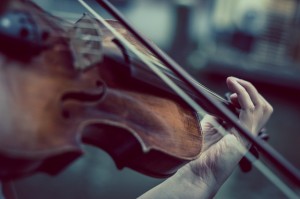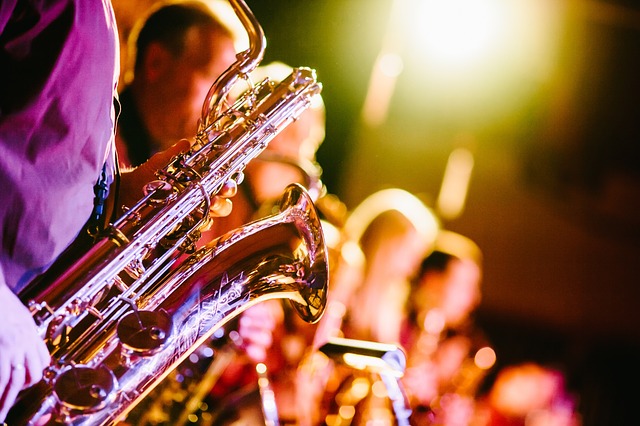Are You a Musical Code-Switcher?
Do any of these scenarios sound familiar?
1. You perform with the symphony in the afternoon, then change out of your formal black, throw your music stand in the trunk, and head straight to a gig with your rock band.
2. On Sunday morning, you accompany a gospel church service, then have an intense chamber music rehearsal in preparation for a premiere.
3. You improvise a burning solo with your jazz combo, mere moments before you leave for a folk music gig at the local coffee house.
If you find yourself making radical changes in musical styles in the course of a single day or week, you might be a musical code-switcher. And if you’re truly proficient at musical code-switching: congratulations! You’re a nimble, flexible musician, with great ears, and quick musical processing ability. Chances are you’re comfortable in several genres, with and without musical notation. You are socially sensitive, willing and able to adapt to musicians from a wide variety of backgrounds. And you probably also have more gigs than you know what to do with!
These are some of the results from our preliminary research, Musical Code-Switching: Musical Interactions in Alternative Music Ensembles, funded by the Paul R. Judy Center for Applied Research. We’re the first researchers to apply the linguistic concept of code-switching to music, and are documenting the hallmarks of this highly beneficial trait. Our key finding is that code-switchers have acquired a deep level of musicianship enhancing any and all styles of musical performance, and they can transfer their musical skills across multiple settings. We want to find out how educators might help more young musicians develop code-switching skills: the ability to make music in many formal and informal ways, from concert halls and recording studios to churches and clubs.
What is Code-Switching?
 In linguistics, code-switching means using more than one way of speaking within a single episode (Heller, 1988). Researchers have applied code-switching theory to understand how people shift between languages or dialects in different situations (Blom and Gumperz, 1972; Lowi, 2005). Code-switching has also been used outside linguistics: NPR’s “Code Switch” broadcast explores “the different spaces we each inhabit and the tensions of trying to navigate between them.” Writers in the Harvard Business Review wrote about code-switching— changing behavior in various situations in accordance with varying cultural norms—as one of the top three skills every 21st-century manager needs.
In linguistics, code-switching means using more than one way of speaking within a single episode (Heller, 1988). Researchers have applied code-switching theory to understand how people shift between languages or dialects in different situations (Blom and Gumperz, 1972; Lowi, 2005). Code-switching has also been used outside linguistics: NPR’s “Code Switch” broadcast explores “the different spaces we each inhabit and the tensions of trying to navigate between them.” Writers in the Harvard Business Review wrote about code-switching— changing behavior in various situations in accordance with varying cultural norms—as one of the top three skills every 21st-century manager needs.
As professors and researchers in music teaching and learning, we are fascinated by the musicians we perceive as fluent in several musical languages. These musicians shift between styles and genres as effortlessly as a bilingual person leaps back-and-forth between languages in a single conversation. We call these versatile performers musical code-switchers, and have observed how code-switchers successfully negotiate musical and social challenges as they move between different groups and genres. But how did these flexible musicians acquire the skills to toggle between various musics? And what specific skills are necessary?
Our Study
Through word-of-mouth, personal knowledge, and recommendations from friends and teachers, we identified 11 Eastman School of Music students that we thought were effective code-switchers: students who perform in multiple genres and move easily across musical worlds. Our participants had to have documented success in multiple genres: potential participants that were the proverbial “jack-of-all-trades, master of none” were excluded. We conducted long interviews with each person, listened to their recordings, and attended their concerts on campus and around Rochester. Their gigs covered a wide spectrum of music, including classical, avant-garde, contemporary, jazz, folk, rock, reggae, bluegrass, Celtic, and ska. We transcribed their interviews and analyzed the data for similar themes across participants.
 Our preliminary findings indicate that musical code-switchers are alive and doing very well at Eastman School of Music. These young musicians derive great satisfaction from their ability to work with varied musical groups. They are proud of their skills, enjoy their gigs, and have an optimistic—and we believe, realistic—outlook on their ability to have a successful multi-genre musical career.
Our preliminary findings indicate that musical code-switchers are alive and doing very well at Eastman School of Music. These young musicians derive great satisfaction from their ability to work with varied musical groups. They are proud of their skills, enjoy their gigs, and have an optimistic—and we believe, realistic—outlook on their ability to have a successful multi-genre musical career.
We also learned important lessons about the type of early musical experiences our participants enjoyed, and uncovered important truths about their in-school musical preparation. The influence of music teachers and the culture of formal music programs, both before and during college, had the potential to positively and negatively impact their willingness and ability to explore musical styles. Our findings therefore, have significant implications for music education at all levels. Here are initial findings; an upcoming book project will offer an in-depth look at code-switching featuring extended participant profiles, paired with interviews of some famous, ultra-successful professional code-switchers.
Code-switching: Musical, Social, and Physical
We analyzed the ways these 11 musicians function in various musical groups, and found commonalities in the way they are able to move between them. Three types of code-switching skills—musical, social, and physical—aid their capacity for successful performance in a number of genres.
Musical. Musical code-switching is marked by an ability to rapidly process, comprehend, and react to musical sounds, in a stylistically appropriate way. Our participants are able to change their tone or style immediately based on aural input from collaborators. Their musical code-switching sensitivity isn’t limited to merely being sensitive to tempos, dynamics, or rhythms, however. These musicians are capable of spontaneous musical dialogue, making and responding to musical statements within the parameters of whatever style of music is being performed. The ability to pick up tunes and progressions by ear, without notation, is a crucial skill for this musical interaction. It is also significant that our participants embrace improvisation. Not all of the participants consider themselves to be outstanding improvisers, but they all stated it is a fundamental skill and one they are willing to practice.
 Several of our participants are able to switch between instruments based on the needs of various groups (i.e. one plays double bass in an orchestra and bass guitar in his rock band; another is majoring in classical piano yet performs regularly on folk fiddle). They have solid, even virtuosic, technique on both instruments. However, even those participants who play a single instrument in multiple styles are skilled at adapting their rhythmic or tonal output to match the musical demands of a particular environment. For example, one cellist reports a keen awareness of rhythm—in terms whether she needs to play ahead of the beat, behind the beat, or “in the pocket”—when she moves between new music ensemble Musica Nova, the Rochester Philharmonic, and her cello rock band. Failure to make these intuitive adjustments would quickly stick out to her colleagues and audience.
Several of our participants are able to switch between instruments based on the needs of various groups (i.e. one plays double bass in an orchestra and bass guitar in his rock band; another is majoring in classical piano yet performs regularly on folk fiddle). They have solid, even virtuosic, technique on both instruments. However, even those participants who play a single instrument in multiple styles are skilled at adapting their rhythmic or tonal output to match the musical demands of a particular environment. For example, one cellist reports a keen awareness of rhythm—in terms whether she needs to play ahead of the beat, behind the beat, or “in the pocket”—when she moves between new music ensemble Musica Nova, the Rochester Philharmonic, and her cello rock band. Failure to make these intuitive adjustments would quickly stick out to her colleagues and audience.
Social. Our participants have sensitivity to subtle social cues. They adapt their vocabulary, use of musical terminology, and personal characteristics in a chameleon-like way, the better to fit in with any group of musicians. They perceive that some times they are the “college kid,” or “that guy with a music degree, ” participating with “working musicians” in the community. Other times, they pick up on a different vibe, and believe they are seen as the renegade, the “rock and roll” player in the college ensemble.
These social perceptions are not a new phenomenon with these musicians; they became sensitive to social dynamics early in their musical life when code-switching first began to take place. Social/musical interactions were fostered in tangible ways by their parents and teachers. Some participants spoke movingly about when and how they learned they could immerse themselves in various groups—say, playing for their teacher in school, and with their friends outside of school—and could inhabit different personas for each.
 Physical. Participants frequently noted they have different physical approaches as they switch between settings: often a by-product of stress and tension. One participant remarked that she brings more “tightness” to classical performances than to the informal sessions outside of school. She noticed, for example that her “face [was] more relaxed when I played fiddle and more intense when I’m playing classical…When I’m just playing a tune that I know, it’s very peaceful.” Capitalizing upon this, she learned that applying the fiddle approach to the classical world helped her alleviate tension, injury, and enhanced her expressivity. The aural acuity and clarity of the bow technique she developed in the classical world also allowed her to play with better intonation in fiddle sessions.
Physical. Participants frequently noted they have different physical approaches as they switch between settings: often a by-product of stress and tension. One participant remarked that she brings more “tightness” to classical performances than to the informal sessions outside of school. She noticed, for example that her “face [was] more relaxed when I played fiddle and more intense when I’m playing classical…When I’m just playing a tune that I know, it’s very peaceful.” Capitalizing upon this, she learned that applying the fiddle approach to the classical world helped her alleviate tension, injury, and enhanced her expressivity. The aural acuity and clarity of the bow technique she developed in the classical world also allowed her to play with better intonation in fiddle sessions.
Common Themes
More Than One Instrument, More Than One Style, in Childhood. Most of our participants had formative musical experiences in their early years of life, which is probably common among most Eastman students. However, what’s different is that these code-switchers learned multiple instruments early on, and moved between them often. Most of our participants had a teacher or important family member who encouraged them to learn and perform on more than one instrument, usually before the age of seven.
Informal Music-making With Family and Friends. Starting from late elementary school, our code-switchers had rewarding formal musical experiences in- and out-of-school, but most recall the time spent—informally and with friends—listening to music, imitating recordings, or composing/arranging tunes as crucial learning opportunities. Most of the 11 participants enjoyed an ever-increasing feeling of musical confidence as they got better at learning and teaching tunes informally, without notation.
 Motivation from Authentic Performance Opportunities, Not Just Lessons. As teens, all the participants had experiences with preparing for actual gigs and performances unrelated to school groups. They were routinely arranging small-group performances with friends or community members: motivated by upcoming shows to learn repertoire and hone their skills. They were thrilled by feeling a personal connection with demonstrative, even rowdy, audiences in settings other than their formal school or studio concerts and recitals. In college, this continued. All participants have frequent opportunities to apply these musical skills in authentic, real-world settings of gigs and jam sessions. Certainly, their stable groups rehearse frequently, but participants were quick to tell us that they fearlessly seek and accept opportunities to perform with new people in unfamiliar locations or styles.
Motivation from Authentic Performance Opportunities, Not Just Lessons. As teens, all the participants had experiences with preparing for actual gigs and performances unrelated to school groups. They were routinely arranging small-group performances with friends or community members: motivated by upcoming shows to learn repertoire and hone their skills. They were thrilled by feeling a personal connection with demonstrative, even rowdy, audiences in settings other than their formal school or studio concerts and recitals. In college, this continued. All participants have frequent opportunities to apply these musical skills in authentic, real-world settings of gigs and jam sessions. Certainly, their stable groups rehearse frequently, but participants were quick to tell us that they fearlessly seek and accept opportunities to perform with new people in unfamiliar locations or styles.
Musicianship. Without exception, our code-switchers have excellent musical skills that extend far beyond being good sight-readers and stylistically appropriate interpreters of notation. While they are all technically fluent on at least one instrument and have mastered the basics of good-quality sound production, their musicianship transcends instrumental skills. They are able to hear, identify, and improvise over harmonic progressions. Their comfort with singing and memorizing melodies and bass lines enables them to quickly learn and teach new tunes to others. Several of the participants compose their own music or make arrangements for their ensembles. Their musicianship, accompanied by their social skills, is helpful when they assume leadership responsibilities in a particular group: guiding rehearsals, offering suggestions, or troubleshooting musical problems.
Conclusion
 A core mission of music education at all levels is to help people develop the skills to continue making music successfully throughout their lives. So it’s crucial that we understand how and when some people become fluent in multiple musical styles, when others do not. We don’t believe that everyone has to become a fluent code-switcher. However, greater access and success within multiple musical worlds is a worthy goal. There are many things music educators in studios, classrooms, and rehearsal halls can do to foster code-switching skills in their students. Based on our research, we believe music educators at all levels can encourage music students to adopt a broader, deeper understanding of what it means to be a comprehensive musician.
A core mission of music education at all levels is to help people develop the skills to continue making music successfully throughout their lives. So it’s crucial that we understand how and when some people become fluent in multiple musical styles, when others do not. We don’t believe that everyone has to become a fluent code-switcher. However, greater access and success within multiple musical worlds is a worthy goal. There are many things music educators in studios, classrooms, and rehearsal halls can do to foster code-switching skills in their students. Based on our research, we believe music educators at all levels can encourage music students to adopt a broader, deeper understanding of what it means to be a comprehensive musician.


No comments yet.
Add your comment